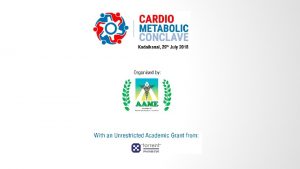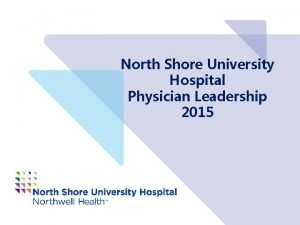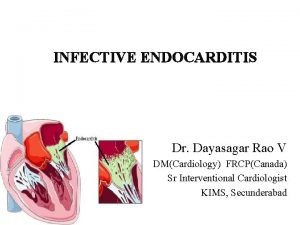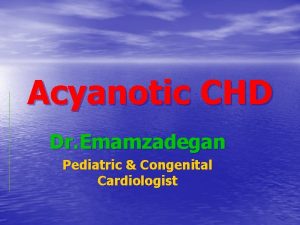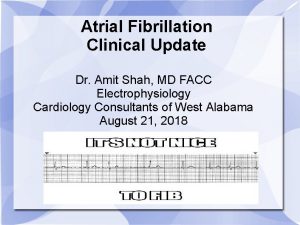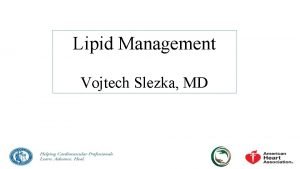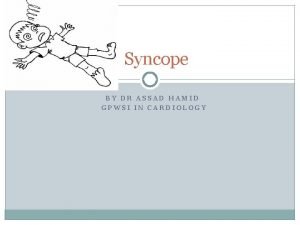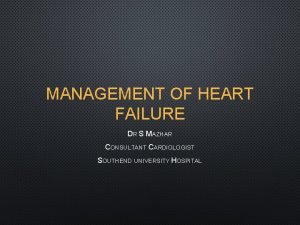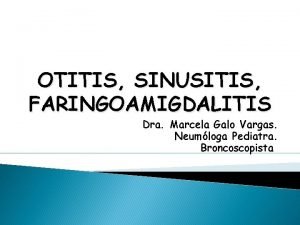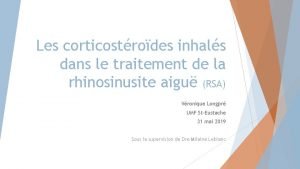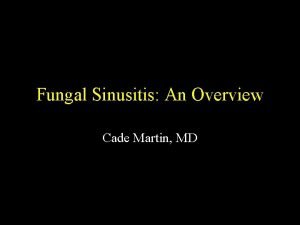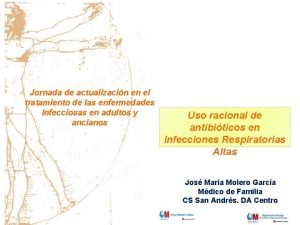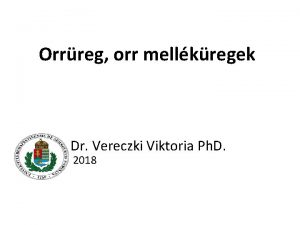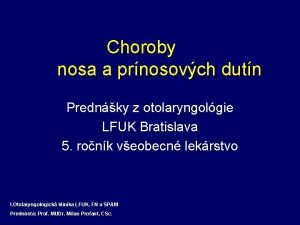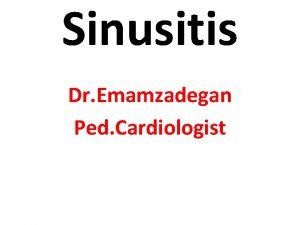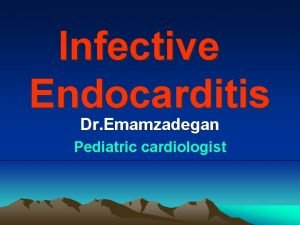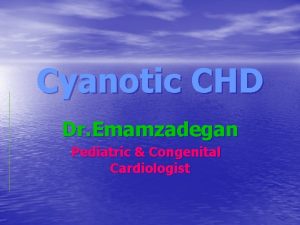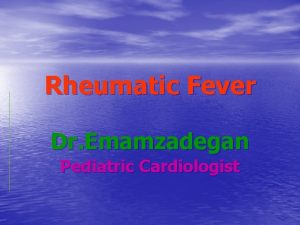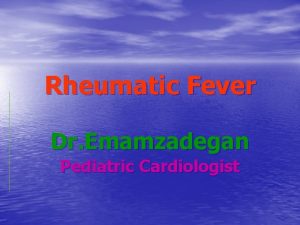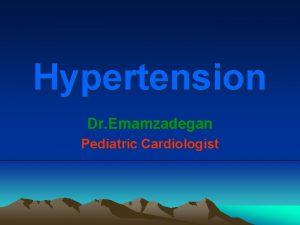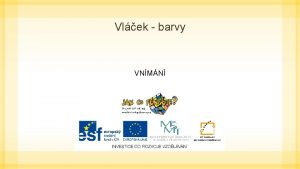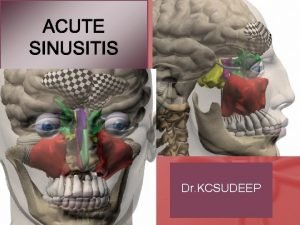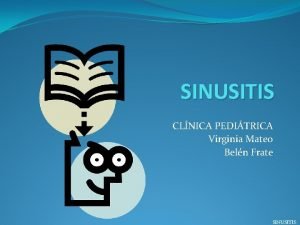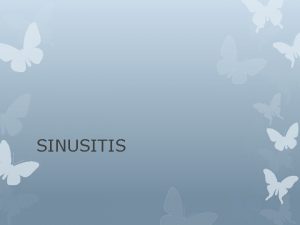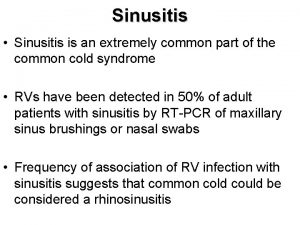Sinusitis Dr Emamzadegan Ped Cardiologist Sinusitis is a
















- Slides: 16

Sinusitis Dr. Emamzadegan Ped. Cardiologist

Sinusitis is a common illness of childhood and adolescence.

Sinusitis There are 2 types of acute sinusitis: viral bacterial

Sinusitis Approximately 0. 5 -2% of viral upper respiratory tract infections in children and adolescents are complicated by acute bacterial sinusitis.

Sinusitis Both the ethmoidal and maxillary sinuses are present at birth, but only the ethmoidal sinuses are pneumatized. The maxillary sinuses are not pneumatized until 4 yr of age. The sphenoidal sinuses are present by 5 yr of age, whereas the frontal sinuses begin development at age 7 -8 yr and are not completely developed until adolescence.

Ethiology The bacterial pathogens causing acute bacterial sinusitis in children and adolescents include Streptococcus pneumoniae (∼ 30%), nontypable Haemophilus influenzae (∼ 20%), and Moraxella catarrhalis (∼ 20%).

Ethiology Staphylococcus aureus, other streptococci, and anaerobes are uncommon causes of acute bacterial sinusitis in children. Although Staphylococcus aureus is an uncommon pathogen for acute sinusitis in children, the increasing prevalence of methicillin-resistant Staphylococcus aureus (MRSA) is a significant concern. H. influenzae, α- and β-hemolytic streptococci, M. catarrhalis, S. pneumoniae, and coagulasenegative staphylococci are commonly recovered from children with chronic sinus disease.

Clinical Manifestations Nasal congestion, purulent nasal discharge (unilateral or bilateral), fever, and cough. Less-common symptoms include bad breath (halitosis), a decreased sense of smell (hyposmia), and periorbital edema. Complaints of headache and facial pain are rare in children. Additional symptoms include maxillary tooth discomfort and pain or pressure exacerbated by bending forward. Physical examination might reveal erythema and swelling of the nasal mucosa with purulent nasal discharge. Sinus tenderness may be detectable in adolescents and adults. Transillumination reveals an opaque sinus that transmits light poorly.

Diagnosis The clinical diagnosis of acute bacterial sinusitis is based on history. Persistent symptoms of upper respiratory tract infection, including nasal discharge and cough, for >10 -14 days without improvement, or severe respiratory symptoms, including temperature of at least (39 C) and purulent nasal discharge for 3 -4 consecutive days.

Diagnosis of chronic sinusitis Children with chronic sinusitis have a history of persistent respiratory symptoms, including cough, nasal discharge, or nasal congestion, lasting >90 days.

Diagnosis • Sinus aspirate culture • Rigid nasal endoscopy • Findings on radiographic studies (sinus plain films, CT scans) including opacification, mucosal thickening, or presence of an airfluid level are not totally diagnostic

Differential Diagnosis Differential diagnostic considerations include viral upper respiratory tract infection, allergic rhinitis, nonallergic rhinitis, and nasal foreign body.

Treatment It is unclear whether antimicrobial treatment of clinically diagnosed acute bacterial sinusitis benefit. offers any substantial

Treatment • Initial therapy with amoxicillin (45 mg/kg/day) • For the penicillin-allergic patient include trimethoprim-sulfamethoxazole, cefuroxime axetil, clarithromycin, or azithromycin. • For children with risk factors (antibiotic treatment in the preceding 1 -3 mo, daycare attendance, or age <2 yr) for the presence of resistant bacterial species, and for children who fail to respond to initial therapy with amoxicillin within 72 hr, treatment with high-dose amoxicillin-clavulanate (80 -90 mg/kg/day of amoxicillin) should be initiated.

Treatment is recommended for 7 days after resolution of symptoms.

Complications periorbital cellulitis and orbital cellulitis epidural abscess Meningitis cavernous sinus thrombosis, subdural empyema, brain abscess osteomyelitis of the frontal bone (Pott puffy tumor), • mucoceles • •
 Cardiologist in kodaikanal
Cardiologist in kodaikanal Dr burton rochelson
Dr burton rochelson Dr sriram rajagopal cardiologist
Dr sriram rajagopal cardiologist Dr nolan cardiologist
Dr nolan cardiologist Dayasagar rao kims
Dayasagar rao kims Complete endocardial cushion defect
Complete endocardial cushion defect Dr amit shah cardiologist
Dr amit shah cardiologist Dr siegfried cardiologist
Dr siegfried cardiologist Dr slezka
Dr slezka Gpwsi cardiology
Gpwsi cardiology Dr mazhar cardiologist
Dr mazhar cardiologist Cultivo faringeo
Cultivo faringeo Inhals
Inhals Black boogers
Black boogers Fenoximetilpenicilin
Fenoximetilpenicilin Calvaria cranii
Calvaria cranii Sinusitis maxillaris chronica
Sinusitis maxillaris chronica
